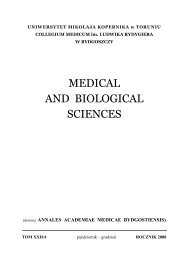Medical and Biological Sciences XXVI/2 - Collegium Medicum ...
Medical and Biological Sciences XXVI/2 - Collegium Medicum ...
Medical and Biological Sciences XXVI/2 - Collegium Medicum ...
You also want an ePaper? Increase the reach of your titles
YUMPU automatically turns print PDFs into web optimized ePapers that Google loves.
<strong>Medical</strong> <strong>and</strong> <strong>Biological</strong> <strong>Sciences</strong>, 2012, 26/2, 41-46<br />
ORIGINAL ARTICLE / PRACA ORYGINALNA<br />
Katarzyna Strojek, Irena Bułatowicz, Agata Czechowska, Agnieszka Radzimińska, Urszula Kaźmierczak,<br />
Grzegorz Srokowski, Marcin Siedlaczek<br />
THE ASSESSMENT OF INFLUENCE OF THERMOPLASTIC FOOT PADS<br />
ON THE BODY STABILITY IN PATIENTS WITH FOOT DYSFUNCTIONS - PILOTY STUDY<br />
OCENA WPŁYWU WKŁADEK TERMOPLASTYCZNYCH NA STABILNOŚĆ CIAŁA<br />
U PACJENTÓW Z DYSFUNKCJAMI STOPY – BADANIA WSTĘPNE<br />
Departament of Kinezytherapy <strong>and</strong> <strong>Medical</strong> Massage <strong>Collegium</strong> <strong>Medicum</strong> in Bydgoszcz Nicolaus Copernicus<br />
University in Torun<br />
Head of the Chair – Doctor of <strong>Medical</strong> <strong>Sciences</strong> Irena Bułatowicz<br />
Urszula Kaźmierczak - Doctor of <strong>Medical</strong> <strong>Sciences</strong><br />
Grzegorz Srokowski – Doctor of <strong>Medical</strong> <strong>Sciences</strong><br />
Katarzyna Strojek – Doctor of <strong>Medical</strong> <strong>Sciences</strong><br />
Agnieszka Radzimińska - Doctor of <strong>Medical</strong> <strong>Sciences</strong><br />
Urszula Kaźmierczak - Doctor of <strong>Medical</strong> <strong>Sciences</strong><br />
Grzegorz Srokowski – Doctor of <strong>Medical</strong> <strong>Sciences</strong><br />
Marcin Siedlaczek – Master of Physiotherapy<br />
Agata Czechowska - Master of Physiotherapy<br />
Summary<br />
Nowadays, we can observe a tendency to reduce the<br />
efficiency of the musculoskeletal system. Currently, the<br />
majority of the population is dominated by a sedentary<br />
lifestyle. The lower limbs are deprived of systematic<br />
locomotion training <strong>and</strong> this is one of the main reasons for<br />
reduction of feet functional efficiency. A sedentary lifestyle<br />
more <strong>and</strong> more often leads to muscles <strong>and</strong> ligaments<br />
inefficiency, which often contributes to the foot dysfunctions.<br />
The aim of this study was to assess the influence of a<br />
thermoform insole on body stability improvement in patients<br />
with foot dysfunctions. The research included 20 people with<br />
one or both feet dysfunctions, qualified to apply modeled<br />
thermoform insole in order to correct the musculo-skeletal<br />
imbalance of a foot. The following foot defects appeared the<br />
most frequently among the people examined: hollow foot,<br />
abducted foot, adducted foot, longitudinal <strong>and</strong> transversal flat<br />
foot. The study was conducted in the Municipal<br />
Rehabilitation Center for Children <strong>and</strong> Youth in Torun, <strong>and</strong><br />
started on the first day of giving an insole to a patient. An<br />
assessment of foot structure <strong>and</strong> functions, <strong>and</strong> lower ankle<br />
joint stability based on static <strong>and</strong> dynamic test on podoscope<br />
were carried out. The height <strong>and</strong> weight were measured. The<br />
BMI, characterizing height-weight ratios, was calculated.<br />
Lower limb lengths were measured in order to detect a<br />
possible asymmetry of limbs, affecting the feeling of a body<br />
stability. After the application of thermoform insoles, a worse<br />
outcome of the final assessment appears in overweight <strong>and</strong><br />
obese people . The size of the insole has no significant effect<br />
on improving the results of the final assessment. In more than<br />
half of the patients, the st<strong>and</strong>ing on one leg test stage of the<br />
diagnostic part was an objective overall examination of body<br />
stability using an electronic platform Freeman Easy Tech<br />
LIBRA®.On the basis of the analysis of the studies, we have<br />
formulated the following conclusions: 1) The use of<br />
thermoform insoles individually tailored to the foot<br />
dysfunctions affects overall improvement in the stability of<br />
the body in patients in all age groups. 2) Patients aged 21<br />
obtained a greater improvement of the parameters researched<br />
than patients aged 22-65. 3) The use of thermoform insoles<br />
had a positive impact on improving the overall surface<br />
deflections in all age groups; in patients aged 22-65 the<br />
improvement was smaller by half of the value. 4) After using

















